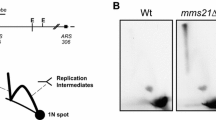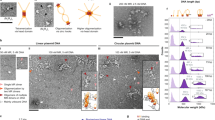Abstract
The evolutionarily conserved Mre11–Rad50–Xrs2 (MRX) complex cooperates with the Sae2 protein in initiating resection of DNA double-strand breaks (DSBs) and in maintaining the DSB ends tethered to each other for their accurate repair. How these MRX–Sae2 functions contribute to DNA damage resistance is not understood. By taking advantage of mre11 alleles that suppress the hypersensitivity of sae2∆ cells to genotoxic agents, we have recently found that Mre11 can be divided in two structurally distinct domains that support resistance to genotoxic agents by mediating different processes. While the Mre11 N-terminal domain impacts on the resection activity of long-range resection nucleases by mediating MRX and Tel1/ATM association to DNA DSBs, the C-terminus influences the MRX-tethering activity by its virtue to interact with Rad50. Given the evolutionary conservation of the MRX complex, our results have implications for understanding the consequences of its dysfunctions in human diseases.


Similar content being viewed by others
References
Bonetti D, Villa M, Gobbini E, Cassani C, Tedeschi G et al (2015) Escape of Sgs1 from Rad9 inhibition reduces the requirement for Sae2 and functional MRX in DNA end resection. EMBO Rep 16:351–361
Cannavo E, Cejka P (2014) Sae2 promotes dsDNA endonuclease activity within Mre11–Rad50–Xrs2 to resect DNA breaks. Nature 514:122–125
Cannavo E, Cejka P, Kowalczykowski SC (2013) Relationship of DNA degradation by Saccharomyces cerevisiae exonuclease 1 and its stimulation by RPA and Mre11–Rad50–Xrs2 to DNA end resection. Proc Natl Acad Sci USA 110:E1661-1668
Cassani C, Gobbini E, Vertemara J, Wang W, Marsella A et al (2018) Structurally distinct Mre11 domains mediate MRX function in resection, end-tethering and DNA damage resistance. Nucleic Acids Res 46:2990–3008
Cejka P, Cannavo E, Polaczek P, Masuda-Sasa T, Pokharel S et al (2010) DNA end resection by Dna2–Sgs1–RPA and its stimulation by Top3–Rmi1 and Mre11–Rad50–Xrs2. Nature 467:112–116
Chen H, Donnianni RA, Handa N, Deng SK, Oh J et al (2015) Sae2 promotes DNA damage resistance by removing the Mre11–Rad50–Xrs2 complex from DNA and attenuating Rad53 signalling. Proc Natl Acad Sci USA 112:E1880-1887
Clerici M, Mantiero D, Lucchini G, Longhese MP (2005) The Saccharomyces cerevisiae Sae2 protein promotes resection and bridging of double strand break ends. J Biol Chem 280:38631–38638
Clerici M, Mantiero D, Lucchini G, Longhese MP (2006) The Saccharomyces cerevisiae Sae2 protein negatively regulates DNA damage checkpoint signalling. EMBO Rep 7:212–218
Daley JM, Gaines WA, Kwon Y, Sung P (2014) Regulation of DNA pairing in homologous recombination. Cold Spring Harb Perspect Biol 6:a017954
de Jager M, van Noort J, van Gent DC, Dekker C, Kanaar R et al (2001) Human Rad50/Mre11 is a flexible complex that can tether DNA ends. Mol Cell 8:1129–1135
Deshpande RA, Williams GJ, Limbo O, Williams RS, Kuhnlein J et al (2014) ATP-driven Rad50 conformations regulate DNA tethering, end resection, and ATM checkpoint signaling. EMBO J 33:482–500
Durdíková K, Chovanec M (2017) Regulation of non-homologous end joining via post-translational modifications of components of the ligation step. Curr Genet 63:591–605
Ferrari M, Dibitetto D, De Gregorio G, Eapen VV, Rawal CC et al (2015) Functional interplay between the 53BP1-ortholog Rad9 and the Mre11 complex regulates resection, end-tethering and repair of a double-strand break. PLoS Genet 11:e1004928
Garcia V, Phelps SE, Gray S, Neale MJ (2011) Bidirectional resection of DNA double-strand breaks by Mre11 and Exo1. Nature 479:241–244
Gobbini E, Villa M, Gnugnoli M, Menin L, Clerici M et al (2015) Sae2 function at DNA double-strand breaks is bypassed by dampening Tel1 or Rad53 activity. PLoS Genet 11:e1005685
Gobbini E, Cassani C, Villa M, Bonetti D, Longhese MP (2016) Functions and regulation of the MRX complex at DNA double-strand breaks. Microb Cell 3:329–337
Hohl M, Kwon Y, Galván SM, Xue X, Tous C et al (2011) The Rad50 coiled-coil domain is indispensable for Mre11 complex functions. Nat Struct Mol Biol 18:1124–1131
Hopfner KP, Karcher A, Craig L, Woo TT, Carney JP et al (2001) Structural biochemistry and interaction architecture of the DNA double-strand break repair Mre11 nuclease and Rad50-ATPase. Cell 105:473–485
Hopfner KP, Craig L, Moncalian G, Zinkel RA, Usui T et al (2002) The Rad50 zinc-hook is a structure joining Mre11 complexes in DNA recombination and repair. Nature 418:562–566
Ira G, Haber JE (2002) Characterization of RAD51-independent break-induced replication that acts preferentially with short homologous sequences. Mol Cell Biol 22:6384–6392
Jinks-Robertson S, Michelitch M, Ramcharan S (1993) Substrate length requirements for efficient mitotic recombination in Saccharomyces cerevisiae. Mol Cell Biol 13:3937–3950
Kaye JA, Melo JA, Cheung SK, Vaze MB, Haber JE et al (2004) DNA breaks promote genomic instability by impeding proper chromosome segregation. Curr Biol 14:2096–2106
Lammens K, Bemeleit DJ, Möckel C, Clausing E, Schele A et al (2011) The Mre11:Rad50 structure shows an ATP-dependent molecular clamp in DNA double-strand break repair. Cell 145:54–66
Lee JH, Paull TT (2007) Activation and regulation of ATM kinase activity in response to DNA double-strand breaks. Oncogene 26:7741–7748
Lee K, Zhang Y, Lee SE (2008) Saccharomyces cerevisiae ATM orthologue suppresses break-induced chromosome translocations. Nature 454:543–546
Leshets M, Ramamurthy D, Lisby M, Lehming N, Pines O (2018) Fumarase is involved in DNA double-strand break resection through a functional interaction with Sae2. Curr Genet 64:697–712
Lim HS, Kim JS, Park YB, Gwon GH et al (2011) Crystal structure of the Mre11–Rad50-ATPγS complex: understanding the interplay between Mre11 and Rad50. Genes Dev 25:1091–1104
Lobachev K, Vitriol E, Stemple J, Resnick MA, Bloom K (2004) Chromosome fragmentation after induction of a double-strand break is an active process prevented by the RMX repair complex. Curr Biol 14:2107–2112
Mehta A, Haber JE (2014) Sources of DNA double-strand breaks and models of recombinational DNA repair. Cold Spring Harb Perspect Biol 6:a016428
Mimitou EP, Symington LS (2008) Sae2, Exo1 and Sgs1 collaborate in DNA double-strand break processing. Nature 455:770–774
Möckel C, Lammens K, Schele A, Hopfner KP (2012) ATP driven structural changes of the bacterial Mre11:Rad50 catalytic head complex. Nucleic Acids Res 40:914–927
Moncalian G, Lengsfeld B, Bhaskara V, Hopfner KP, Karcher A et al (2004) The Rad50 signature motif: essential to ATP binding and biological function. J Mol Biol 335:937–951
Nakada D, Matsumoto K, Sugimoto K (2003) ATM-related Tel1 associates with double-strand breaks through an Xrs2-dependent mechanism. Genes Dev 17:1957–1962
Nakai W, Westmoreland J, Yeh E, Bloom K, Resnick MA (2011) Chromosome integrity at a double-strand break requires exonuclease 1 and MRX. DNA Repair 10:102–110
Nicolette ML, Lee K, Guo Z, Rani M, Chow JM et al (2010) Mre11–Rad50–Xrs2 and Sae2 promote 5′ strand resection of DNA double-strand breaks. Nat Struct Mol Biol 17:1478–1485
Nimonkar AV, Genschel J, Kinoshita E, Polaczek P, Campbell JL et al (2011) BLM-DNA2-RPA-MRN and EXO1-BLM-RPA-MRN constitute two DNA end resection machineries for human DNA break repair. Genes Dev 25:350–362
Niu H, Chung WH, Zhu Z, Kwon Y, Zhao W et al (2010) Mechanism of the ATP-dependent DNA end-resection machinery from Saccharomyces cerevisiae. Nature 467:108–111
Park YB, Chae J, Kim YC, Cho Y (2011) Crystal structure of human Mre11: understanding tumorigenic mutations. Structure 19:1591–1602
Paull TT, Gellert M (1998) The 3′ to 5′ exonuclease activity of Mre11 facilitates repair of DNA double-strand breaks. Mol Cell 1:969–979
Pommier Y, Sun Y, Huang SN, Nitiss JL (2016) Roles of eukaryotic topoisomerases in transcription, replication and genomic stability. Nat Rev Mol Cell Biol 17:703–721
Puddu F, Oelschlaegel T, Guerini I, Geisler NJ, Niu H et al (2015) Synthetic viability genomic screening defines Sae2 function in DNA repair. EMBO J 34:1509–1522
Reginato G, Cannavo E, Cejka P (2017) Physiological protein blocks direct the Mre11–Rad50–Xrs2 and Sae2 nuclease complex to initiate DNA end resection. Genes Dev 31:2325–2330
Robert T, Vanoli F, Chiolo I, Shubassi G, Bernstein KA, Rothstein R, Botrugno OA, Parazzoli D, Oldani A, Minucci S, Foiani M (2011) HDACs link the DNA damage response, processing of double-strand breaks and autophagy. Nature 471:74–79
Runge KW, Li Y (2018) A curious new role for MRN in Schizosaccharomyces pombe non-homologous end-joining. Curr Genet 64:359–364
Schiller CB, Lammens K, Guerini I, Coordes B, Feldmann H et al (2012) Structure of Mre11–Nbs1 complex yields insights into ataxia-telangiectasia-like disease mutations and DNA damage signaling. Nat Struct Mol Biol 19:693–700
Seifert FU, Lammens K, Stoehr G, Kessler B, Hopfner KP (2016) Structural mechanism of ATP-dependent DNA binding and DNA end bridging by eukaryotic Rad50. EMBO J 35:759–772
Shibata A, Moiani D, Arvai AS, Perry J, Harding SM et al (2014) DNA double-strand break repair pathway choice is directed by distinct MRE11 nuclease activities. Mol Cell 53:7–18
Shim EY, Chung WH, Nicolette ML, Zhang Y, Davis M et al (2010) Saccharomyces cerevisiae Mre11/Rad50/Xrs2 and Ku proteins regulate association of Exo1 and Dna2 with DNA breaks. EMBO J 29:3370–3380
Stewart GS, Maser RS, Stankovic T, Bressan DA, Kaplan MI et al (1999) The DNA double-strand break repair gene hMRE11 is mutated in individuals with an ataxia-telangiectasia-like disorder. Cell 99:577–587
Trujillo KM, Yuan SS, Lee EY, Sung P (1998) Nuclease activities in a complex of human recombination and DNA repair factors Rad50, Mre11, and p95. J Biol Chem 273:21447–21450
Usui T, Ogawa H, Petrini JH (2001) A DNA damage response pathway controlled by Tel1 and the Mre11 complex. Mol Cell 7:1255–1266
Villa M, Cassani C, Gobbini E, Bonetti D, Longhese MP (2016) Coupling end resection with the checkpoint response at DNA double-strand breaks. Cell Mol Life Sci 73:3655–3663
Wang W, Daley JM, Kwon Y, Krasner DS, Sung P (2017) Plasticity of the Mre11–Rad50–Xrs2–Sae2 nuclease ensemble in the processing of DNA-bound obstacles. Genes Dev 31:2331–2336
Williams RS, Moncalian G, Williams JS, Yamada Y, Limbo O et al (2008) Mre11 dimers coordinate DNA end bridging and nuclease processing in double-strand-break repair. Cell 135:97–109
Williams RS, Dodson GE, Limbo O, Yamada Y, Williams JS et al (2009) Nbs1 flexibly tethers Ctp1 and Mre11–Rad50 to coordinate DNA double-strand break processing and repair. Cell 139:87–99
Williams GJ, Williams RS, Williams JS, Moncalian G, Arvai AS et al (2011) ABC ATPase signature helices in Rad50 link nucleotide state to Mre11 interface for DNA repair. Nat Struct Mol Biol 18:423–431
Wiltzius JJ, Hohl M, Fleming JC, Petrini JH (2005) The Rad50 hook domain is a critical determinant of Mre11 complex functions. Nat Struct Mol Biol 12:403–407
Zhu Z, Chung WH, Shim EY, Lee SE, Ira G (2008) Sgs1 helicase and two nucleases Dna2 and Exo1 resect DNA double-strand break ends. Cell 134:981–994
Acknowledgements
We thank all members of the Longhese lab for helpful discussions. This work was supported by the Associazione Italiana per la Ricerca sul Cancro (AIRC) (IG Grant 19783) and Progetti di Ricerca di Interesse Nazionale (PRIN) 2015 to M. P. L. C. C. was supported by a fellowship from Fondazione Italiana Ricerca sul Cancro (FIRC).
Author information
Authors and Affiliations
Corresponding authors
Ethics declarations
Conflict of interest
The authors declare that they have no conflict of interest.
Additional information
Communicated by M. Kupiec.
Rights and permissions
About this article
Cite this article
Marsella, A., Cassani, C., Casari, E. et al. Structure–function relationships of the Mre11 protein in the control of DNA end bridging and processing. Curr Genet 65, 11–16 (2019). https://doi.org/10.1007/s00294-018-0861-5
Received:
Revised:
Accepted:
Published:
Issue Date:
DOI: https://doi.org/10.1007/s00294-018-0861-5




